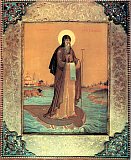

| Previous day | Next day |
| Old Style
July 3
|
Monday |
New Style
July 16
|
| 8th Week after Pentecost. Tone 6. | No fast.
|
![]() Martyr Hyacinth of Caesarea in Cappadocia (108).
Martyr Hyacinth of Caesarea in Cappadocia (108). ![]() Second translation of the relics of Hieromartyr Philip, metropolitan of Moscow and all Russia (1652).
Second translation of the relics of Hieromartyr Philip, metropolitan of Moscow and all Russia (1652).
Martyrs Diomedes, Eulampius, Asclepiodotus, and Golinduc (2nd c.). Martyrs Mocius and Mark (4th c.). St. Alexander, founder of the Monastery of the Unsleeping Ones, Constantinople (ca. 430). St. Anatolius, patriarch of Constantinople (458). St. Anatolius, recluse, of the Near Caves in Kiev (12th c.) and St. Anatolius (another), recluse, of the Far Caves in Kiev (13th c.). Repose of St. Basil, bishop of Ryazan (1295). Sts. Basil and Constantine, princes of Yaroslavl (13th c.). Sts. John and Longinus of Yarenga, monks of Solovki (1561). Blessed John of Moscow, fool-for-Christ (1589). St. Nicodemus of Khozyuga, monk of Kozhaezersk Monastery (1640). St. Basil, archbishop of Novgorod (1352). Blessed Michael, Herodion, Basil, and Thomas, fools-for-Christ, of Solvychegodsk (17th c.).
New Hieromartyr Anthony (Bystrov), archbishop of Arkhangelsk and Kholmogorsk (1931).
“Milk-Giver” Icon of the Most Holy Theotokos of Hilandar, Mt. Athos.
St. Anatolius, bishop of Laodicea, and his successor, St. Eusebius (3rd c.). St. Germanus, bishop of the Isle of Man and enlightener of Peel, nephew of St. Patrick of Ireland (474). St. Isaiah the Solitary, of Scetis and Palestine (ca. 489). St. Symeon the Stylite (the third), of Cilicia (6th c.). St. George the Godbearer, of the Black Mountain, teacher of St. George of Mt. Athos (1068). St. Joachim, monk, of Notena in Achaia (17th c.). New Monk-martyr Gerasimus the New, of Carpenision, at Constantinople (1812). Martyrs Theodotus and Theodota, martyred with St. Hyacinth at Caesarea in Cappadocia (108).
Repose of Nun Euphrosyne “the Unknown,” of Kolyupanovo (Aleksin) (1855).
Thoughts for Each Day of the Year
According to the Daily Church Readings from the Word of God
By St. Theophan the Recluse

Monday. [I Cor. 9:13-18; Matt. 16:1-6]
The Pharisees and Sadducees desired of the Lord that He would show them a sign, but they did not see the sign before their very eyes. The Lord Himself was the sign—His teaching and deeds clearly showed who He was; no additional evidence was needed. The works that I do…they bear witness of me (John 10:25), He said to the Jews. The Lord denounced them, saying, Ye can discern the face of the sky, but the signs of the times ye cannot discern. Why did this happen with them? Because they lived an outward life, and did not enter within themselves. Without collectedness, without attentiveness and without self-searching it is impossible to notice or comprehend the works of God. This has continued until this day. Christianity is before everyone’s eyes as the true sign of God; but those who look at it do not see this, are shaken in faith and step away. Their eyes lose the ability to see the stamp of divinity in it, and they are ready to ask for special signs from heaven, like the Jews. But a sign is not given and shall not be given, because those who seek this do so only to tempt, and not in order to walk the path of Christ. Just enter onto this path, and from the first step you will see that it is divine, that it leads to God and brings God nearer to you. The Lord said to the Jews: “there shall no sign be given…but the sign of the prophet Jonas.” The Lord foresaw today’s unbelievers as well, and prepared for them an answer: Then shall appear the sign of the Son of man in heaven: and then shall all the tribes of the earth mourn… (Matt. 24:30).
Articles
 Martyr MociusThe Holy Martyrs Mocius and Mark were arrested as Christians and brought to trial by the governor Maximian. |
 Martyr MarkThe Holy Martyrs Mocius and Mark were arrested as Christians and brought to trial by the governor Maximian. |
 St Basil the Bishop of Ryazan |
 Right-believing Prince Basil of Yaroslavl |
 Right-believing Prince Constantine of YaroslavlIn their youth they lost their father, Vsevolod, who fell in battle with the Tatars (Mongols). St Basil, the elder brother, succeeded to the throne. |
 Venerable Nicodemus the Abbot of Kozhe Lake |
 St George the God-BearerSaint George the God-bearer and Recluse labored in the Black Mountains near Antioch during a time when the churches and monasteries there flourished. |










